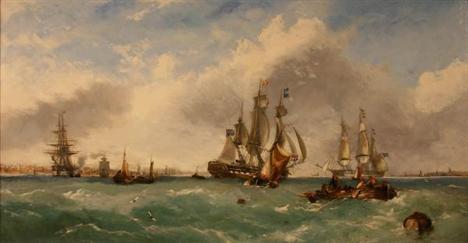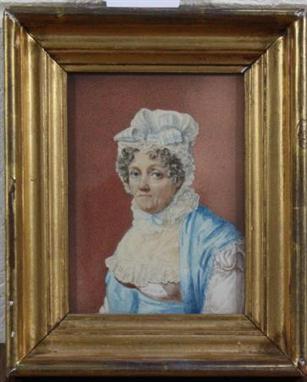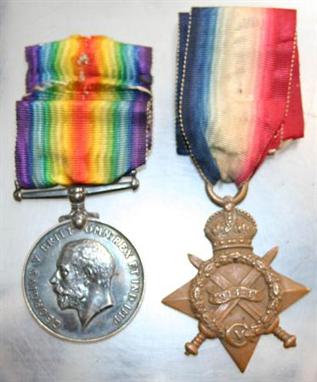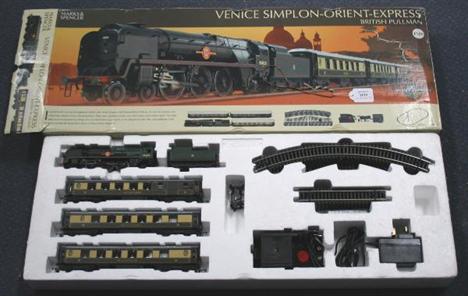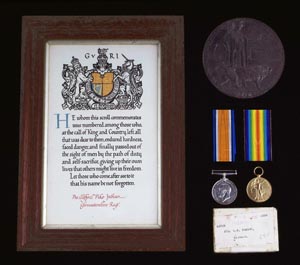We found 297887 price guide item(s) matching your search
There are 297887 lots that match your search criteria. Subscribe now to get instant access to the full price guide service.
Click here to subscribe- List
- Grid
-
297887 item(s)/page
A 1914-15 Star and 1914-18 British War Medal to `1782 Pte. T.C. Danton. Midd`x R.` (attempted erasure to `Midd`x` on the British War Medal), a First World War period memorial plaque, detailed `Thomas Danton`, and a memorial card, detailed `Pte Thomas Tucker Dantan` [died 14th October 1918, buried in the St. Pancras Cemetery, Finchley] (Note: Victory Medal lacking).
A 1914-15 Star, 1914-18 British War Medal and 1914-19 Victory Medal to `G-3080 Pte W.C. Hawkins. R.Suss.R., mounted on a bar as worn, a 1914-15 Star, 1914-18 British War Medal and 1914-19 Victory Medal to `3081 Pte. W.A. Hawkins. R.Suss.R.`, and a 1914-18 British War Medal to `55630 Pte. E. Hawkins. Essex R.`.
A 1914-18 British War Medal and 1914-19 Victory Medal to `Sister R. White.`, a ribbon bar showing additionally the Royal Red Cross and a misplaced MID spray, a Queen Alexandra`s Imperial Military Nursing Service Reserve Medal, various paperwork referring to the award of the Royal Red Cross, 2nd class, to Miss Rubie White, 37th General Hospital, an OHMS packet, an enamelled Red Cross badge, a Victoria Jubilee Head half crown 1887, mounted as a brooch, two commemorative medallions, a bangle, fitted with a variety of mostly silver coins, and a waist belt buckle with scroll pierced decoration.
A 1914-15 Star, British War Medal and Victory Medal to `A-1459 Pte. C. Wickes K.R.Rif.C.`, with memorial plaque to Charles Wickes [died 30th July 1915, commemorated on panel 51 and 53, Ypres (Menin Gate) Memorial], a 1914-15 Star, British War Medal and Victory Medal to `5499 Pte. H. Wickes The Queen`s R.`, [brother of Charles Wickes], a Princess Mary 1914 gift tin, a Victory Medal to `Pte. Bonnett Lines R.`, a trench art pickle fork made from an inert Mauser cartridge, detached sections of page 15 of the Evening Telegraph Toronto, Soldiers` Tely, 12-11-1918 , folded in a tin case, and a photograph of a trench.
A Victorian mahogany and gilt lacquered brass biunial magic lantern projector by W.C. Hughes, the lacquered brass fittings and lens mounts with numerous adjustments and two self centring R. Beard`s slides, the mahogany body applied with a plaque inscribed `W.C. Hughes, Brewster House, 82 Mortimer Road, London, N`, beneath a japanned-metal chimney, on a moulded rectangular base, height approx 65cm.
A Hornby Railways 00 gauge R-374 4-6-2 locomotive No. 210166 `Spitfire` and tender, an R-857 2-6-0 locomotive and tender, an R-380 4-4-0 school`s class locomotive and gender, finished in Southern green livery, and seven other Hornby and Tri-ang locomotives and tenders (some renamed or repainted), all boxed (boxes creased and scuffed).
A Hornby Railways 00 gauge R-353 0-6-0 tank locomotive (repainted in Southern black livery), an R-057 0-4-0 tank locomotive, an R-255 0-4-0 passenger tank locomotive (repainted black), an R-059 0-6-0 tank locomotive (repainted in GWR green livery No. 3682), an R-055 2-6-4 tank locomotive (repainted in black LMS livery), and an R-754 0-4-4 tank locomotive (repainted in Southern green livery), all within window boxes (boxes creased, scuffed and torn).
A Hornby Railways 00 gauge 4-6-2 locomotive `Flying Scotsman` and tender, two diesel locomotives, a High Speed Train set, a Tri-ang RS-30 train set, a Hornby Railways R-571 Co-Co diesel, a Mainline 4-6-0 locomotive and tender, and a collection of rolling stock, track and accessories, some boxed (playwear and faults, boxes creased and scuffed).
A Great War Group of Four to Private F.R. Benthall, 16th Battalion, (Queen’s Westminster Rifles) London Regiment, 1914 - 15 Star (2980 Pte. F.B. Benthall. 16-Lond.R.), British War and Victory Medals (2980 Pte. F.B. Benthall. 16-Lond. R.), Special Constabulary Long Service Medal (Sergt. Francis B. Benthall), fine if not better. A silver cigarette case, inscribed “ F.B. Benthall, from the Officer’s of A. Company, 3/6th City of London Rifles, on the occasion of his marriage, Jan.15, 16Õ. Miss Dora Mann (fl. 1898-1907) Portrait miniature of a rifleman in khaki uniform, half length. Signed and dated 1900 middle right. 6cm x 4.8cm, oval. In a gilt metal frame. 1/16th (Queens Westminster Rifles), London Regiment. 1914 - The 1/16th County of London Battalion (Queens Westminster Rifles, The County of London Regiment (Territorial Force) mobilised on the 4th of August 1914 at the Queen’s Hall, Buckingham Gate Westminster. Arrived in France November 1914 then 18th Brigade, 6th Division.
A Third Reich 1933 Pattern Dagger, Sturmabteilungen, broad double-edged blade, typically engraved “Alles Fur DeutschlandÕ, bearing the R. Haastert & Bull, Soligen-Wald, makers mark, nickel plated and SA emblem to hardwood grip, in its brown painted steel sheath, with nickel plated mounts, hanging ring and belt clip, stamped RZM M5/71.
A Great War D.C.M. Group of Four to Private E. Jones, 2nd Battalion, Leinster Regiment, Distinguished Conduct Medal, GRV (6-584 Pte. E.Jones. 2/Leins.R.); 1914-15 Star (584 Pte. E. Jones. Leins. R), British War and Victory Medals (584 Pte. E. Jones. Leins. R.), very fine, if not better, together with photograph of recipient. The Leinster Regiment. 2nd Battalion - August 1914; At Cork, part of 17th Brigade in the 6th Division, moved to Newmarket; 12th September 1914 - Landed at Nazaire; 14th October 1915 - Transferred with Brigade to the 24th Division; 19th October 1915;Transferred to 73rd Brigade, same Division; 1st February 1918; Moved to Tincourt and transferred to the 47th Brigade from disbanded 7th Battalion; 13th April 1918; Absorbed troops from disbanded 6th Connaught Rangers; 23rd of April 1918; transferred to the 88th Brigade in 29th Division
A Great War Group of Three to Corporal E. Comer, 2nd Battalion, Devonshire Regiment, Killed in Action at The Second Battle of Villers-Bretonneux, 24th of April 1918. 1914 Star (8376 Pte. E. Comer. 2/Devon:R), British War and Victory Medals (8376 Cpl. E. Comer. Devon. R.) Corporal Ernest Comer of the 23rd Brigade, 8th Division, 2nd Battalion, Devonshire Regiment was killed in action on the 24th of April 1918, aged 29, Son of the late Harry and Emma Comer and husband of Lilian Comer of Castle Hill, Hemyock, Cullompton, Devon, he has no known grave but is remembered with honour at the Pozieres Memorial. The Second Battle of Villers-Bretonneux, came during the period of The Battle of Lys, 24 - 27 of April 1918, but was launched against the British front lines in front of Amiens. The Germans had developed a small number of tanks, and used them during this offensive, thirteen of their model A7V’s supported the advance, making it the largest use of German tanks in the Great War. The attack was preceded by artillery, using both mustard gas and high explosive rounds, the Germans quickly engulfed and broke through the 8th Division, making a three mile wide gap in the British line. Villers-Bretonneux fell to the advancing Germans, and the main strategic centre of Amiens became under immediate threat. General Henry Rawlinson responded by launching a counter-attack, his plan to use two Australian units in a pincer manoeuvre, the 15th Brigade under General Thomas William Glasgow would attack north of the town and the 13th under General H.E. “PompeyÕ Elliott, the south, British troops would offer support, in a role that would see them through the gap between the Australians. Artillery support was available, but to achieve surprise, there would be no barrage to soften up the German positions. The attack took place on the night of the 24th and 25th of April, the operation had originally been due to start at 8 pm, but General Glasgow argued that it would still be light at this time, and would cause terrible consequences for his men, after much debate it was decided that the attack would commence at 10 pm. Entrenched German machine gun teams began taking a toll on the advancing Australians, but this never deterred them from their objective, and after a number of courageous charges, the two brigades swept around the town, successfully capturing the German positions, by night fall, Villers-Bretonneux had been recaptured. Lieutenant Ledward 23rd Brigade, 8th Division. “At Villiers - Bretonneux the battalions were decimated in six hours by the perfectly infernal bombardment. Very few prisoners were taken. The German tanks did serious execution too. They moved over our trenches and enfiladed them so that the wretched defenders were rendered defenceless and stood helplessly to be mown down. But it was the bombardment that did the worst damage. That was truly ghastly business.Õ..
A Great War Western Front, Delville Wood, Casualty Group of Three to Private Clifford Pike Fabian of the 12th Battalion (Bristol’s Own), Gloucestershire Regiment, British War and Victory Medals (22705 Pte. C. P. Fabian. Glouc. R.), extremely fine, in card box of issue; Great War Memorial Plaque (Clifford Pike Fabian) with framed and glazed Memorial Scroll. Private Clifford Pike Fabian, of the 12th “Bristol’s OwnÕ Gloucestershire Regiment, son of Mrs Florence Anne Fabian of 707 Fishponds Road, Bristol, was killed in action at Delville Wood on the 29th July 1916 aged 19, he has no known grave, but is remembered with honour at the Thiepval Memorial. 12th Battalion Gloucestershire Regiment “Bristol’s OwnÕ. The boys of Bristol were heavily involved in the fierce fighting in and around Longueval and Guillemont, South of the infamous Delville Wood from the end of July to September 1916, during the second phase of the Battle of the Somme. Originally formed on the 3rd of September 1914, the 12th Battalion immediately became known as “Bristol’s OwnÕ. At first the boys of “Bristol’s Own were allowed to live at home and many continued to work, eventually the temporary buildings constructed for the Bristol International Exhibition at Bower Ashton were used as an HQ for the battalion. Ashton Court estate and Ashton Park were used for outdoor training. The Battalion arrived in France on the 21st of November 1915, with a complement of 27 officers and 886 men and spent some time in the quiet area of the Somme, moving to Arras during the spring and early summer of 1916. The Battle of the Somme began on the 1st of July 1916 and the Battalion was moved back there on the 20th of July. By the end of the month they were in the line facing Delville Wood - “Devil’s WoodÕ as it had already been called.
An 18th Century wine glass; the ogee bowl raised on a multiple spiral twist stem with a flattened ball knop 16 1/4in. (16cms) high (small chip to rim), together with and early 19th Century ale tumbler engraved "Pike & Eel E . R" above a spray of barley 4 1/4in. (11cms); and a bladed knopped rummer engraved with farmers arms opposite "WM" within a cartouche 5 1/4in. (13cms).
R B Spencer (attrib.): a pair of gilt framed 19th century oils on canvas; Naval Battle Scenes - The Battle of Cape St. Vincent, before and after, depicting various ships engaging in battle (19 x 31 inches), (both relined). In the Battle of Cape St Vincent (14 February 1797) a British fleet under John Jervis defeated a larger Spanish fleet under José de Córdoba near Cape St. Vincent, Portugal.
11 various collectors/transport interest books. Road Vehicles of the great western Railway by P.J. Kelley, (OPC). Scale Model Soldiers by R Dilley, (Almark). War Game Campaigns by D. Featherstone (Stanley Paul). War Gaming Through The ages 3,000 BC to 1,500AD by D. Featherstone (Stanley Paul). History Of British Dinky Toys 1934-1964 C. Gibson (Mikansue). Postwar British Motorcycles by C. Ayton (Hamlyn). How To Go Plastic Modelling by C. Ellis (PSL). Horseless Carriages by D. Tubbs (Edita Lausanne). Little Wars by H.G. Wells (AAP). Jane’s Historical Aircraft 1902-1916 by C.G. Grey (Jane’s-Macdonald. Plus the Illustrated History Of Motorcycles by E. Tragatsch (New Burlington) plus a few war gamers booklets. GC Some light wear to most.
Britains Soldiers. 1950’s examples. Scots Guards Review order c.1900. 6 Guardsmen with rifles, at ease, Officer with drawn sword. Officer. Colour Bearer. 2 Pioneers with axes. Infantry of the line (white facings) Review order c1900-7 Infantrymen standing to attention and a marching officer. Officer Highland Regiment review order marching, identified on base: LT LO 1R R. CAN. 81A. British R.A. India service dress standing with tropical helmet. Plus a Herald plastic Scots Guards Pipe Major, marching-repainted. In a Britains Band box, A.F. Contents VGC
4 Corgi heavy haulage Haig Transport set CC99192 comprising Volvo FH Skeletal Trailer/Container and Renault Premium Curtainside, Guy Invincible 8-Wheel Tipper Arthur Duckett, Scammell Crusader Flatbed Trailer J R Adams, Atkinson Borderer Fridge Van Gibbs of Fraserburgh. All boxed, minor wear to 2, contents as new.
Six: Order of St Michael and St George CMG neck badge in Garrard case, CBE, in a DS&S case; WWII War Medal, 1937 Coronation, 1953 Coronation, TD undated, GVF, mounted as worn, with miniatures. Together with much ephemera relating to the recipient A R W Robertson, a financial secretary wtih the British Government serving various territories. Plate 3
1914 star (MS 3527 Pte H J Weld, ASC) NEF; Pair: BWM and Victory (59609 Pte G F Jack R Scots) GVF. WWII: group of 4: 1939-45 star, Africa star, Defence and War with miniatures; Pair: Defence and War; Pair: Defence and War with Special Constabulary LS, EIIR issue with 2 LS clasps for 1971 and 1981 (Arthur E Barnett) VF. Miniature group of 7: 1914 star with clasp, BWM, Victory, 1939-45 star, F&G star, Defence, War and single GSM with clasp N Ireland. 2 sundry other pieces.
† Four: 1914-15 star, (5-1940 Pte J W (corrected) Bourne R Sussex R), BWM and Victory (119653 Gnr J W Bourne RA), Defence medal (un-named as issued) VF. Together with reprints taken from approx 240 letters, field service postcards etc from recipient to family members back home. Note: James Bourne volunteered for the Cinque Ports Bttn 5th Royal Sussex. In Feb 1915 he joined A Company in France. In March he received wounds to the leg and foot at Festubert. A period of convalescence in England followed. On 21st July 1915 he obtained a commission with the 2/5th S Staffs Regt and in October left again for France as 2nd Lieut. In January 1916 he went to Egypt with the regiment but fell out with the Colonel. In February the regiment returned to France. He then resigned his commission in April. When conscription was introduced he rejoined the army as a gunner RGA. In February 1917 he was again sent to France for service. After promotion to Bombardier in May he fell ill in June with Rheumatic Fever and Angina. Again he was sent back for convalescence but was finally posted to France again with506 Siege Battery.
23 post war A3 recruiting posters, printed on card with suspension loops, Regular Army, 4 types, Scots Guards, Light Division, Territorial Arms, Grenadier Guards, R Armoured Corps, R Artillery, R Marines, RM Commandos, RNR, WRAC, etc, all with appropriate scenes, uniformed figures and slogans; in a folder. VGC
An RN officer’s embroidered cap badge, pair 6th Armoured and 8 other cloth badges; an RFC WM swagger cane top; a US leather bayonet frog with long brass belt hook; approx 2½ lbs buttons, rank badges etc, large buttons include silver plated R Scots (9), gilt Jersey Customs (8), S Rly (2), London & S Western Rly, etc. Generally GC
32 collar badges, officers pairs, silvered Middlesex Regt, gilt and silvered RAMC, bronze RA, ORs pairs: RA, R Fusiliers, RAOC, RASC (2 prs), 14 others. 35 brass shoulder titles, pairs, 7th Gurkhas, RFA, RGA, RCMP, ATS, RAMC, R Signals, CEF, RB, RA, South African Infantry. Singles: Coldstream Guards, RTR, 11H, 16/5L, RAOC, 9 others, 10 trade badges, Driver, Gun Layer, 8 others. GC (9 lugs missing). (68)
A post 1902 RN Midshipman’s dirk, SE blade 18½”, by J R Gaunt & Son, late Edward Thurkle, 53 Conduit St, London W (the firm’s address 1906-18), etched with crowned fouled anchor, R Arms and motto within oak wreaths, scrolled panels, regulation brass hilt, acorn finial crossguard with crowned fouled anchor in wreath to centre, lion’s head pommel and backstrap, wirebound sharkskin grip, in its brass mounted leather scabbard with locking clip to hilt. GC (light pitting to blade edges)
An early 19thC shaped rectangular porcelain dish by H & R Daniel of Stoke-on-Trent, painted to centre with a gilt crest, a lion statant on a chapeau gules with turned up ermine beneath a crown, within a wide bright green border painted with four cartouches depicting either a basket of flowers or an exotic bird with elaborate gilt scroll borders - puce painted marks `H & R Daniel, Stoke upon Trent, Staffordshire` - reputedly part of a service commissioned by the Earl of Shrewsbury, 11.5" across
-
297887 item(s)/page



